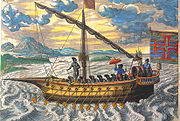
Fusta
Encyclopedia

Oar
An oar is an implement used for water-borne propulsion. Oars have a flat blade at one end. Oarsmen grasp the oar at the other end. The difference between oars and paddles are that paddles are held by the paddler, and are not connected with the vessel. Oars generally are connected to the vessel by...
s and sail -– in essence a small galley. It typically had 12 to 18 two-man rowing benches on each side, a single mast with a lateen
Lateen
A lateen or latin-rig is a triangular sail set on a long yard mounted at an angle on the mast, and running in a fore-and-aft direction....
(triangular) sail, and usually carried two or three guns. The sail was used to cruise and save the rowers’ energy, while the oars propelled the ship in and out of harbor and during combat.
The fusta was the favorite ship of the North African corsairs of Salé
Salé
Salé is a city in north-western Morocco, on the right bank of the Bou Regreg river, opposite the national capital Rabat, for which it serves as a commuter town...
and the Barbary Coast
Barbary Coast
The Barbary Coast, or Barbary, was the term used by Europeans from the 16th until the 19th century to refer to much of the collective land of the Berber people. Today, the terms Maghreb and "Tamazgha" correspond roughly to "Barbary"...
. Its speed, mobility, capability to move without wind, and its ability to operate in shallow water -- crucial for hiding in coastal waters before pouncing on a passing ship -- made it ideal for war and piracy. It was mainly with fustas that the Barbarossa brothers, Baba Aruj
Aruj
Aruj or Arouj was the elder brother of Barbarossa Hayreddin Pasha and Ottoman Bey of Algiers and Beylerbey of the West Mediterranean...
and Khair ad Din carried out the Turkish conquest of North Africa and the rescue of Mudéjar
Mudéjar
Mudéjar is the name given to individual Moors or Muslims of Al-Andalus who remained in Iberia after the Christian Reconquista but were not converted to Christianity...
s and Morisco
Morisco
Moriscos or Mouriscos , meaning "Moorish", were the converted Christian inhabitants of Spain and Portugal of Muslim heritage. Over time the term was used in a pejorative sense applied to those nominal Catholics who were suspected of secretly practicing Islam.-Demographics:By the beginning of the...
s from Spain after the fall of Granada
Granada
Granada is a city and the capital of the province of Granada, in the autonomous community of Andalusia, Spain. Granada is located at the foot of the Sierra Nevada mountains, at the confluence of three rivers, the Beiro, the Darro and the Genil. It sits at an elevation of 738 metres above sea...
and that they and the other North African corsairs wrought terror upon Christian shipping and the islands and coastal areas of the Mediterranean in the 16th and 17th centuries.
Literature
- Bicheno, Hugh, Crescent and Cross: The Battle of Lepanto 1571, Phoenix Paperback, London, 2004, ISBN 1-84212-753-5
- Svat Soucek, "The Ottomans and Their Rivals, Galleys and Galleons, Portolan Charts and Isolarii," in his Piri Reis & Turkish Mapmaking After Columbus: The Khalili Portolan Atlas, Nour Foundation, 1995 (pp. 10-33).

